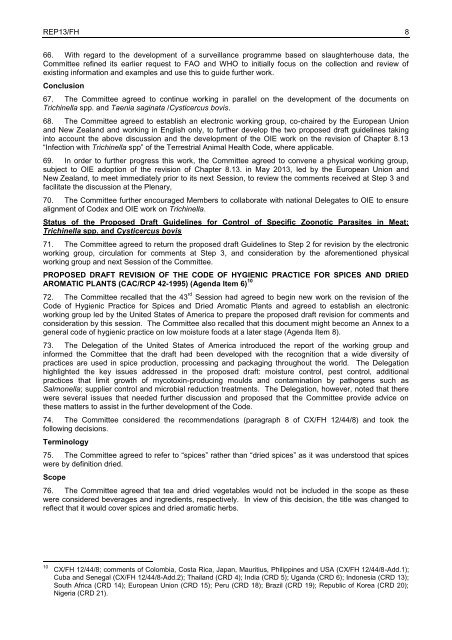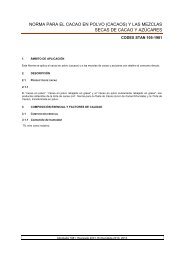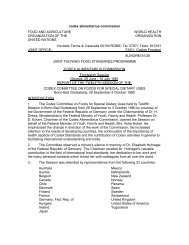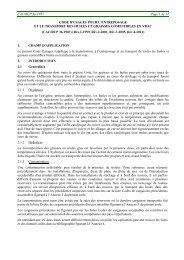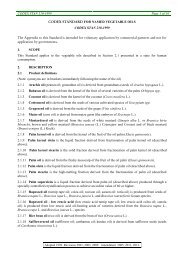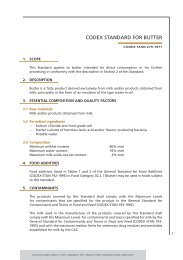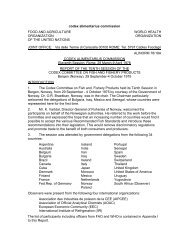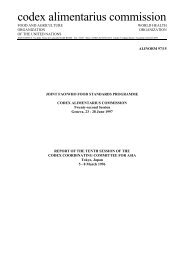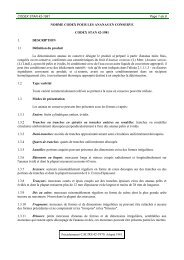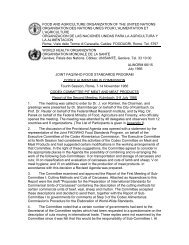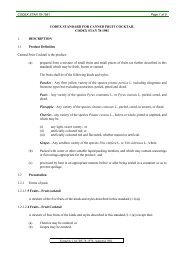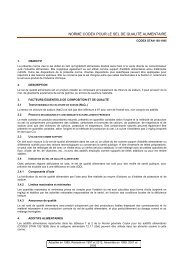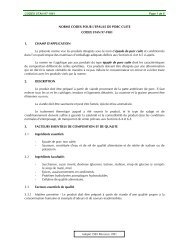REP13/FH JOINT FAO/WHO FOOD STANDARDS PROGRAMME ...
REP13/FH JOINT FAO/WHO FOOD STANDARDS PROGRAMME ...
REP13/FH JOINT FAO/WHO FOOD STANDARDS PROGRAMME ...
You also want an ePaper? Increase the reach of your titles
YUMPU automatically turns print PDFs into web optimized ePapers that Google loves.
<strong>REP13</strong>/<strong>FH</strong> 8<br />
66. With regard to the development of a surveillance programme based on slaughterhouse data, the<br />
Committee refined its earlier request to <strong>FAO</strong> and <strong>WHO</strong> to initially focus on the collection and review of<br />
existing information and examples and use this to guide further work.<br />
Conclusion<br />
67. The Committee agreed to continue working in parallel on the development of the documents on<br />
Trichinella spp. and Taenia saginata /Cysticercus bovis.<br />
68. The Committee agreed to establish an electronic working group, co-chaired by the European Union<br />
and New Zealand and working in English only, to further develop the two proposed draft guidelines taking<br />
into account the above discussion and the development of the OIE work on the revision of Chapter 8.13<br />
“Infection with Trichinella spp” of the Terrestrial Animal Health Code, where applicable.<br />
69. In order to further progress this work, the Committee agreed to convene a physical working group,<br />
subject to OIE adoption of the revision of Chapter 8.13. in May 2013, led by the European Union and<br />
New Zealand, to meet immediately prior to its next Session, to review the comments received at Step 3 and<br />
facilitate the discussion at the Plenary,<br />
70. The Committee further encouraged Members to collaborate with national Delegates to OIE to ensure<br />
alignment of Codex and OIE work on Trichinella.<br />
Status of the Proposed Draft Guidelines for Control of Specific Zoonotic Parasites in Meat:<br />
Trichinella spp. and Cysticercus bovis<br />
71. The Committee agreed to return the proposed draft Guidelines to Step 2 for revision by the electronic<br />
working group, circulation for comments at Step 3, and consideration by the aforementioned physical<br />
working group and next Session of the Committee.<br />
PROPOSED DRAFT REVISION OF THE CODE OF HYGIENIC PRACTICE FOR SPICES AND DRIED<br />
AROMATIC PLANTS (CAC/RCP 42-1995) (Agenda Item 6) 10<br />
72. The Committee recalled that the 43 rd Session had agreed to begin new work on the revision of the<br />
Code of Hygienic Practice for Spices and Dried Aromatic Plants and agreed to establish an electronic<br />
working group led by the United States of America to prepare the proposed draft revision for comments and<br />
consideration by this session. The Committee also recalled that this document might become an Annex to a<br />
general code of hygienic practice on low moisture foods at a later stage (Agenda Item 8).<br />
73. The Delegation of the United States of America introduced the report of the working group and<br />
informed the Committee that the draft had been developed with the recognition that a wide diversity of<br />
practices are used in spice production, processing and packaging throughout the world. The Delegation<br />
highlighted the key issues addressed in the proposed draft: moisture control, pest control, additional<br />
practices that limit growth of mycotoxin-producing moulds and contamination by pathogens such as<br />
Salmonella; supplier control and microbial reduction treatments. The Delegation, however, noted that there<br />
were several issues that needed further discussion and proposed that the Committee provide advice on<br />
these matters to assist in the further development of the Code.<br />
74. The Committee considered the recommendations (paragraph 8 of CX/<strong>FH</strong> 12/44/8) and took the<br />
following decisions.<br />
Terminology<br />
75. The Committee agreed to refer to “spices” rather than “dried spices” as it was understood that spices<br />
were by definition dried.<br />
Scope<br />
76. The Committee agreed that tea and dried vegetables would not be included in the scope as these<br />
were considered beverages and ingredients, respectively. In view of this decision, the title was changed to<br />
reflect that it would cover spices and dried aromatic herbs.<br />
10<br />
CX/<strong>FH</strong> 12/44/8; comments of Colombia, Costa Rica, Japan, Mauritius, Philippines and USA (CX/<strong>FH</strong> 12/44/8-Add.1);<br />
Cuba and Senegal (CX/<strong>FH</strong> 12/44/8-Add.2); Thailand (CRD 4); India (CRD 5); Uganda (CRD 6); Indonesia (CRD 13);<br />
South Africa (CRD 14); European Union (CRD 15); Peru (CRD 18); Brazil (CRD 19); Republic of Korea (CRD 20);<br />
Nigeria (CRD 21).


